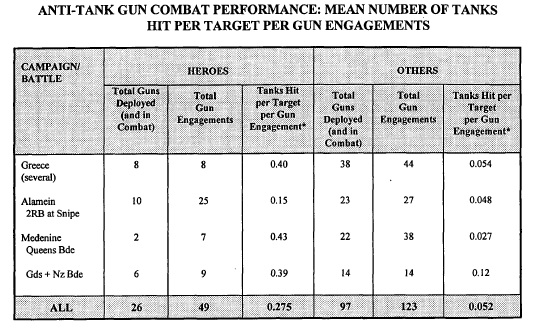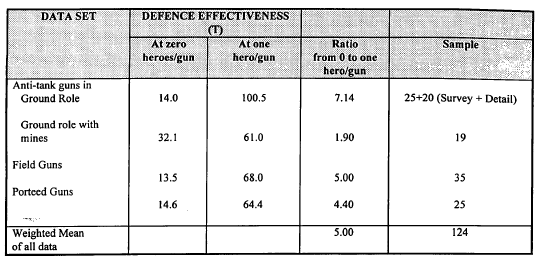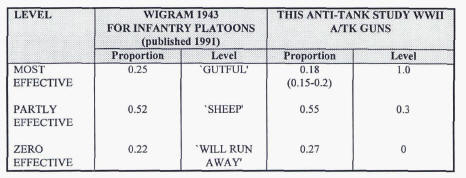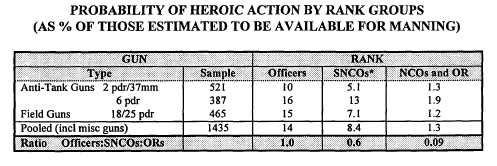
Heroes
This essay is inspired by Assessing the effect of Heroism on Combat Effectiveness by D Rowland and A Richardson: ismor.cds.cranfield.ac.uk/14th-symposium-1997/assessing-the-effect-of-heroism-on-combat-effectiveness/@@download/paper/rowland.pdf
In brief the study looks in detail at several engagements by British AT guns and rates the performance of guns manned by at least one soldier that won a medal in the engagement. It compares them to guns that had no medal winners. The medal winners being described as heroes.
This is Table 1 from the report

It very clearly shows the superiority of heroes when they are manning AT guns, with a metric of 0.275 vs 0.053. That makes heroes just over five times as effective as non-heroes which is a huge difference.
The metric: tanks hit per target per gun engagement, is interesting. This is the proportion of targets hit from those available to be shot at. So if 10 tanks attacked a gun position and 3 were hit that would yield a metric of 0.3. The paper postulates the performance of heroes is the same as the performance of all soldiers during peace time field trials and manoeuvres. As the training of the troops in the same units is probably roughly similar, this implies that the lower performance of the majority of soldiers is due to combat stress of some kind rather than differences in competence. This is supported by Heroes: http://www.mindlesseating.org/pdf/heroism/Heroism.doc which lists medal winners as more: self-disciplined, resourceful, self-confident, adventurous, flexible and risk-taking than those that did not win medals. The research didn't not specifically ask about training but as can be seen Heroes have many other attributes that would be applicable under stress.
The hit rate is interesting. The best soldiers only hit 27.5% of the available targets and the others only hit 5%. Either accuracy in battle is much reduced, or soldiers do not fire at targets even though they could clearly do so. More on this later.
Looking at the numbers above it can be seen that 21% of guns were crewed by at least one hero. Heroes were involved in 28% of engagements.
Next the paper asserts that AT guns are 2.5 to 3 times as effective as tanks in the defence. Most of the supporting evidence for this is in another paper which is unfortunately unavailable to me. I seen no reason to doubt the authors of the paper in which case this has huge implications for all wargames rules. I can not think of a single one where AT guns shoot better than tanks, including BBWW2B. In the paper opines that this increased performance is due the higher ratio of command personnel in AT units, as command personnel have a higher chance of being heroes.
The next table shows effectiveness in different situations.

The "T factor" is measure of gun effectiveness.
The first interesting difference is between scenarios with and without mines. This can simply be explained by the fact that the mines delay the enemy offering more opportunities to shoot. This increases the kill rate of the majority so the heroes' rate drops correspondingly.
The extra mobility of porteed guns seems to have little effect on the majority but curtails the effect of the heroes. My hypothesis is being a hero in a honking great truck which is easy to hit reduces a potential hero's life expectancy.
As can be seen Heroes are five times more effective than non-heroes.
The research then takes a look at how the non heroes are made up ad compares the totals to some WW2 research on infantry.

Its rather shocking to see that about a quarter of men are completely useless (though some women I know would think that this percentage is much too low!). One quarter of men in a unit contribute nothing to the battle. Accounting for them, the remainder of non-heroes have there effectiveness compared to heroes increased to 30%. This is data for UK soldiers but other research shows casualty data for all nations is similar, so it seems reasonable to assume that the distribution of effectiveness is similar in other armies.
This has huge implications for those that play skirmish games. None of those I have ever played show such dramatic difference in individuals. You might argue that a game could represent the average shooting effect across a squad, but if you are going to do that why play skirmish? However playing games where a stand represents many troops the average effect can be taken.
As an aside, and talking of research that has huge implications for skirmish games (and perhaps others), the following piece of research indicates that small arms accuracy gets worse within 100m of the enemy rather than gets better. Which as far as I know isn't indicted in any rules set I've seen: http://www.ismor.com/33ismor_archive/papers/33ismor_salt_paper.pdf
The next table gives us some indication of who the heroes are.

Unfortunately there is no indication of the prevalence of "zero effectives" amongst SNCOs and Officers, but none the less the command structure must account for a significant portion of a formation's combat power. This breakdown is only proven for the British.
The Soviet army has a reputation for poor NCOs (see: http://www.dtic.mil/dtic/tr/fulltext/u2/a098467.pdf ) and a reputation for poorer combat performance that western nations. Its quite possible that the two phenomena are linked.
For the skirmish players, given that heroes are more prevalent amongst officers that means that there are even fewer hero squaddies.
The conclusion to be drawn is the majority of a unit's combat power (50-75%) hinges on the performance of 20-28% of the units personnel. This has profound implications for the design of skirmish games. Its impact on larger scale games is less profound, but the revelation that AT guns are 2.5 to 3 times more effective than tanks will require consideration.
In the future I will write an essay on casualties. NCOs and officers take proportionately more casualties than the rank and file and more of a unit's combat power is invested in them. This will have an effect on the degradation of a unit's fighting ability as it takes losses.